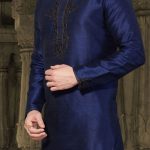India’s land gives unique products like silk from Assam or dyes from the southeast to make special clothes. Every place has its own kind of fabric, thanks to local treasures. From cotton to silk, these materials had worn people far and wide before factories came.
Understanding Fabric Choices
When choosing fabric for traditional Indian clothing, knowing its roots is key. India’s rich land offers unique fibers and dyes central to crafting these garments. Local resources like Assam’s golden silks or Bengal’s fine cotton have defined regional attire for centuries.
Artisans skillfully turn raw materials such as silk and cotton into distinctive textiles through weaving, dyeing, and embroidery. Silk is especially prized in traditional wear, with tasar silk being abundant in regions like Odisha. This ‘wild’ silk showcases the harmony between nature and craftsmanship necessary for creating authentic pieces.
Similarly important are natural dyes like indigo, which require deep knowledge to be used effectively without chemical binders. Understanding this blend of tradition and technique enriches your appreciation when selecting fabrics for traditional outfits.
Selecting the Right Color Palette
When picking the right color palette for traditional Indian apparel, consider colors with deep meaning. Red stands out as a top choice because it brings thoughts of love, joy, and purity. It’s not just popular; it also carries luck in Indian culture.
Imagine your wedding dress or decor shining bright in red paired with sparkling gold—a combo often seen at Hindu weddings for its richness and promise of prosperity. Gold is another must—consider hue due to its ties with wealth and elegance. Whether through your bridal jewelry or table settings, adding gold can elevate the look instantly while symbolizing happiness and success.
Don’t forget about green, either—known for bringing vibes of harmony, new beginnings, and nature into your space. Matching green within attire combinations effectively can be tricky. However, incorporating this shade could add depth and reflect peace throughout special day settings.
Choosing wisely between these vibrant colors can make all the difference when planning trends moving forward, especially given their cultural significance, keeping traditions alive whilst maybe even setting some new ones along the way, too.
Emphasizing Traditional Embroidery Techniques
When you choose traditional Indian apparel, pay close attention to the embroidery. It tells a story of craftsmanship and culture that stretches back centuries. For example, Gujarat’s chain stitching was sold to Europe through the East India Company in the 16th century.
Its intricate patterns were loved for making home items like bed covers. Aari’s work is another technique with deep roots in India’s history. Crafted with a hook needle known as an awl, it originated from the Mochi community, which first used this skill on leather goods before adapting it for textiles.
Zardozi takes luxury up a notch using gold or silver threads laid down spirally and tacked onto fabric. Despite its high-cost today, it remains a favorite among royals for palace decor and special attire. Don’t forget about Chikan from Lucknow, famous worldwide for its tiny stitches on soft cotton with delicate floral designs.
Kantha from Bengal transforms old clothes into artful pieces with unique embroidery styles, while Phulkari from Punjab uses bright silk threads to create vibrant flower designs on simple backgrounds.
Considering Occasion and Formality Levels
When picking what to wear, think about the event and how formal it should be. At weddings, traditional outfits shine. Women might pick a lehenga, while men could go for a sherwani.
Everyone dresses up to celebrate love by joining hands. Festivals are next with their burst of color and joy. People wear sarees or kurta-pajamas during Diwali or Holi, which adds beauty to these times. Then, there are religious events where clothes show faith and respect. Sarees at temples highlight devotion. Don’t forget family parties!
Traditional attire also brings us together, making everything feel special. Cultural outings like dance shows offer chances to showcase beautiful heritage through dress. Lastly, even formal meets can see you stand out in ethnic wear that turns heads kindly your way.
Anarkalis make waves at big occasions with their grace; they’re tightly fitted and flow down broadly, marked by gorgeous details. Indo-Western pieces capture many fans among youths—blending styles gives cool results! Sarees have new looks now—different wrap ways add fresh twists, turning all eyes toward them!
Remember, each choice says something lovely about the traditional meeting today, right?
Sizing and Fitting Best Practices
When picking traditional Indian wear, it’s key to get the fit just right. Start by measuring your body exactly where you plan to wrap or drape the clothing. For sarees and lehengas, focus on your waist size and how long you want them to be.
Kurtas need their chest, waist, and arm lengths checked for a perfect match. Use a tailor’s tape measure for this; cloth tapes give more precise numbers than metal ones. Remember that each style may sit differently on your body, so add an inch extra when in doubt. It’s better to be slightly loose than too tight.
Also, if shopping online, look at the size charts provided carefully; these can help ensure your order fits as it should once it arrives. Lastly, reading reviews from other buyers about sizing experiences with similar items before making a final choice helps avoid mistakes here, too.
Exploring Regional Variations
Indulging in India’s diverse cultural heritage requires a thorough exploration of regional variations in traditional apparel. Each region boasts its own distinctive styles and designs, making the selection process an enriching experience.
The North offers vibrant colors and intricate embroidery through garments like Punjabi salwar kameez and regal lehenga cholis. In Western India, elegance is embodied by sarees with Gujarati and Rajasthani influences featuring eye-catching mirror work and bold patterns.
Southern India showcases opulence with Kanjeevaram silk sarees known for their luxurious textures and exquisite zari detailing. At the same time, Eastern India exudes simplicity yet charm through Bengali sarees adorned with delicate kantha embroidery.
By understanding these nuances unique to each region, one can effortlessly choose attire that accurately reflects their traditions and impeccable craftsmanship.



